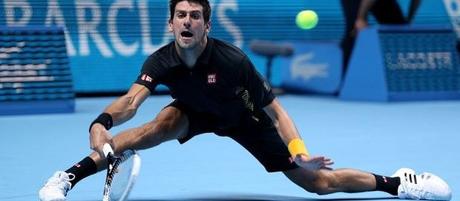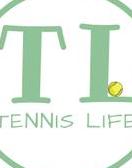
There are many factors that make a tennis player a good defensive player: speed, anticipation, footwork and, of course, execution. How, where and why you hit the ball can get you back into the point and possibly turn the tables and put your opponent on the defensive end of the point.
When pulled out of position, many of us resort to hitting a "Hail Mary"... the all-or-nothing winner. Unfortunately, this type of desperation shot is a very low-percentage/high risk strategy, resulting in many more errors than not.
On the other hand, a good defensive player utilizes more options, all of which are safer and smarter than the all-or-nothing desperation shots.
So what are safer shot selections to when you find yourself on the defense and out of position? Here are some different scenarios and some table-turning plays:
When you are pulled way off of the court...
Your opponent has you running off the court for a wide-angle shot. The problem here is that once you return the ball, you'll be way out of position to get to the next ball your opponent hits. You need to buy yourself some time after you hit your shot to get back into a good position on the court.
So what to do? Well, hitting the ball hard will only cut your recovery time down since it will reach the other side of the court quicker. The best solution would be to hit a deep lob and get back to the middle of the baseline (in singles tennis). The more advanced players can hit a heavy topspin lob or a high heavy topspin shot. Hitting this shot over the head of the player at net works for doubles as well.
Lobbing keeps the ball in the air and out of your opponent's reach for a longer time than a groundie would, allowing you time to get back to position and back into the point. Lobbing also makes it harder for your opponent(s) to hit a winner off of a deep, high shot that has no pace. Make sure and hit it deep into the court, or your opponent might be able to take it as an overhead.
Depending on where your opponent is and how fast they move, hitting the ball cross-court can also be a good defensive shot. Taking some pace off the ball and hitting a deep cross-court shot allows the ball a longer distance to travel, giving you a little more time to get back into position. Just remember that the harder you hit the ball, the faster the ball will cover that distance, and the less time you will have to recover and get into a decent position for your next shot.
When your opponent comes to the net on a great approach shot...
In this situation, your opponent has hit a great approach shot, pinning you behind the baseline. Believe it or not, you actually have several options for good defensive play:
The lob is always a good choice (especially in doubles), but when you are playing taller or quicker opponents, they can make you pay for such a shot if you don't execute it perfectly. Always be sure to hit your lobs deep in the court, and if you can hit with lots of topspin, that's an added bonus.
Hitting at their feet is also very effective, especially against taller players. Hit the ball with less pace and more topspin (a "dipper"), which will hopefully will dip down over the net and land at their feet (preferably to their backhand side) as they are coming in to the net. Make sure to follow your shot in, as their next shot will most likely be a pop up from low to high and without much pace, setting you up for a possible put-away volley.
The last thing you want to do is to go for an near impossible winner and miss, which is the same as giving them a free point. So hit it right at 'em instead! Hit the ball hard and keep it low (with topspin), and aim right for the body on their backhand side. Since they are getting closer to the net, they won't have much time to react to a fast ball - especially a low one. Unless they're an extremely good player, their next shot will either be an error, a pace-less pop up which you can put away with a volley, or some other awkward return which will allow you another chance at getting back into the point. Sometimes hitting the ball hard but low, and right at their body will in many cases, result in them making an error, or at most, returning an awkward shot which will allow you back into the point.
The ultimate goal here is to force them to hit a shot that is not as effective as their approach shot, so if you can force them to run down a topspin lob or hit a sloppy shot, you can quickly gain control of the point and put your opponent on the defensive end.
When you're being out-powered while on the baseline...
When your opponent is on the baseline and you're being out-powered and forced to move from side to side, hitting the ball becomes much more of a challenge. At this stage of the point, you don't want to try and match power with power - especially if that's not your strength. Instead of hitting harder, slow down your shots and aim the ball into the deepest open part of the court. It's much harder for your opponent to generate pace on the ball when you don't give them much pace to work with.
Also, if changing the direction of the ball is a weapon in your tennis arsenal, use it to your advantage WHEN YOU CAN, and make them run. But don't attempt this if you're on the run or way down in the score. In those instances, if they hit the ball cross-court, hit it back cross-court. Changing the direction of the ball is a much more difficult shot and requires spot-on timing to execute, so play it safe and send the ball back from where it came from.
When defending against a good lob
If you're at the net and your opponent hits a good lob that you can barely reach, you don't have to hit a 120 mph overhead. If you're backing up extremely fast and are fully stretched to hit the overhead, chances are that swinging big will only get you in more trouble. It is perfectly acceptable to hit an overhead at 50 percent pace and keep yourself in the point. The key here is placement... the further away from your opponent, the better.
I know it's tempting to go for a big winner when in a bad spot, but sometimes you need to play it safe and try to incorporate the above options into your game. I guarantee you that in the long run, you will win more points by playing smarter rather than playing harder.


